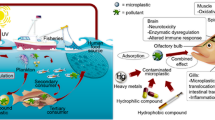Abstract
-
Part I: Determination and identification of organic pollutants Part II: Results of the biotest battery and development of a biotest index
-
Preamble. This series of two papers presents the results of an interdisciplinary research project (ISIS) dealing with bioassay-directed fractionation of marine sediment extracts. Part I presents the extraction and fractionation procedure as well as the results of chemical analysis, including non-target analysis of sediments. Part II describes the results of the biotest battery in relation to chemicals possibly causing parts of the observed effects. A biotest index is used to compare the toxicities of the samples.
-
AUTHORS / AFFILIATIONS Ninja Reineke (3), Werner Wosniok (4), Dirk Danischewski (1), Heinrich Hühnerfuss (3), Angelika Kinder (5), Arne Sierts-Herrmann (5), Norbert Theobald (2), Hans-Heinrich Vahl (6), Michael Vobach (1), Johannes Westendorf (6) and Hans Steinhart (5).
-
(1) Federal Research Centre for Fisheries, Institute for Fishery Ecology, Palmaille 9, 22767 Hamburg, Germany (2) Federal Maritime and Hydrographic Agency, Bernhard-Nochtstr. 78, 20359 Hamburg, Germany (3) University of Hamburg, Institute for Organic Chemistry, Martin-Luther-King-Platz 6, 20146 Hamburg, Germany (4) University of Bremen, Institute of Statistics, Bibliothekstr. 1, 28334 Bremen, Germany (5) University of Hamburg, Institute for Food Chemistry, Grindelallee 117, 20146 Hamburg, Germany (6) University of Hamburg, University Hospital Hamburg-Eppendorf, Department for Toxicology, Vogt-Kölln-Str. 30, 22527 Hamburg, Germany (7) Eurofins Wiertz-Eggert-Jörissen, Stenzelring 14b, 21107 Hamburg, Germany
Goal, Scope and Background
The ecological relevance of contaminants in mixtures is difficult to assess, because of possible interactions and due to lacking toxicity data for many substances present in environmental samples. Marine sediment extracts, which contain a mixture of environmental contaminants in low concentrations, were the object of this study. The extracts were investigated with a set of different biotests in order to identify the compound or the substance class responsible for the toxicity. For this goal, a combination of biotests, biotest-directed fractionation and chemical analysis has been applied. Further on, a strategy for the development of a biotest index to describe the toxicity of the fractions without a prior ranking of the test results is proposed. This article (Part II) focuses on the biological results of the approach.
Methods
The toxicological potential of organic extracts of sediments from the North Sea and the Baltic Sea was analyzed in a bioassay-directed fractionation procedure with a set of biotests: luciferase reporter gene assays on hormone receptor and Ah receptor, arabinose resistance test, fish embryo test (Danio rerio), comet assay, acetylcholinesterase inhibition test, heat-shock protein 70 induction, oxidative stress and luminescence inhibition test (Vibrio fischeri). The test results provided the basis for the calculation of a biotest index by factor analysis to compare the toxicity of the samples and fractions.
Results and Discussion
Results of 11 biotests on different fractionation levels of the samples were described and discussed with regard to the occurrence of contaminants and their toxic potentials. Polychlorinated biphenyls, polycyclic aromatic hydrocarbons, quinones, brominated indoles and brominated phenols were in the focus of interest. A biotest index was constructed to compare the toxic responses in the samples and to group the biotest results.
Conclusion
The procedure presented in this study is well suited for bioassay-directed fractionation of marine sediment extracts. However, in relatively low contaminated samples, high enrichment factors and sufficient fractionation is necessary to allow identification of low concentrations of contaminants which is required to link effects and possible causes. In the present case, the relation between substances and effects was difficult to uncover due to relatively low concentrations of pollutants compared to the biogenic matrix and to the remaining complexity of the fractions. The results, with respect to the brominated phenols and indoles in the samples, highlight the successful use of bioassay directed fractionation in the case of high concentrations and high toxicity.
Recommendation and Outlook
In general, it has been shown that a marine risk assessment requires focusing on the input of diffuse sources and taking into account the fact of mixture toxicity. Effects resulting from biogenic substances will make the assessment of the influence of anthropogenic substances even more difficult.
Similar content being viewed by others
Author information
Authors and Affiliations
Corresponding authors
Rights and permissions
About this article
Cite this article
Kammann, U., Biselli, S., Reineke, N. et al. Bioassay-directed Fractionation of Organic Extracts of Marine Surface Sediments from the North and Baltic Sea - Part II: Results of the biotest battery and development of a biotest index (8 pp). J Soils Sediments 5, 225–232 (2005). https://doi.org/10.1065/jss2004.10.124.2
Received:
Accepted:
Published:
Issue Date:
DOI: https://doi.org/10.1065/jss2004.10.124.2




